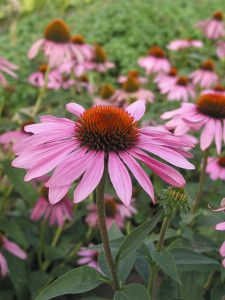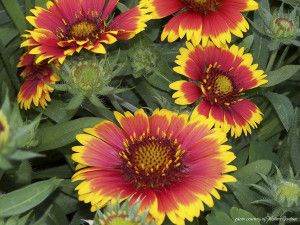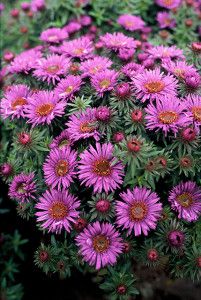
Growing Bee Friendly
Table of Contents
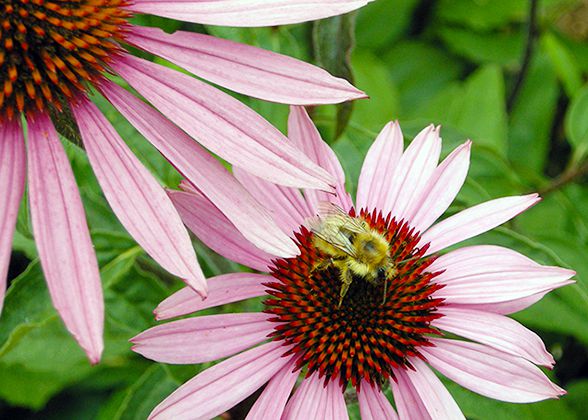 With summer’s arrival, it’s a great time to celebrate our pollinators.
With summer’s arrival, it’s a great time to celebrate our pollinators.
Honeybees, and especially wild native bees, need our continued support as they struggle to overcome habitat loss, climate change, disease, and exposure to toxins in the environment. Did you know that there are over 855 species of wild native bees in Canada? Bumble bees, mason bees, sweat bees, leafcutting bees, mining bees, squash bees and more…
Attracting pollinators into your garden with nourishing sources of nectar is the best support you can offer these species and we’re highlighting a few perennials best suited across the major growing regions of Canada. Planting just one of these perennials into your garden can help our bees and other pollinators thrive in urban environments.
Veronica spicata ‘Royal Candles’ – Speedwell
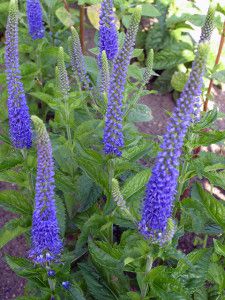 Invite butterflies and bees to the sweet nectar held in these deep purple blue flowering spikes in early summer. Veronica ‘Royal Candles’ is an easy to grow perennial where it performs best in full sun and well-draining soils. It will also tolerate partial shade. Deadheading spent blooms promotes additional flowering – and bee foraging – throughout the summer. Its compact dwarf habit makes it ideally suited for mixed borders or containers.
Invite butterflies and bees to the sweet nectar held in these deep purple blue flowering spikes in early summer. Veronica ‘Royal Candles’ is an easy to grow perennial where it performs best in full sun and well-draining soils. It will also tolerate partial shade. Deadheading spent blooms promotes additional flowering – and bee foraging – throughout the summer. Its compact dwarf habit makes it ideally suited for mixed borders or containers.
Height: 45 cm (18”) Spread: 30 cm (12”) Zones: 3-9
Liatris spicata – Blazing Star
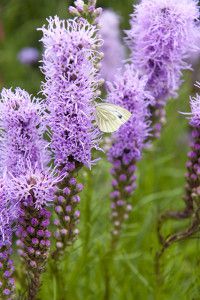
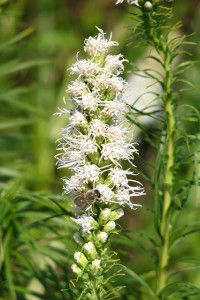 This torch bearer of fluffy white or rose purple flowering heads in July and August is a true haven for butterflies, bees, rare moths and hummingbirds. Originally a native wildflower to North American prairies and grasslands, Blazing Star withstands poor soils, hot summers, cold winters, even drought conditions. The plant blooms from the top downward. Cut off the top portion of the flower head that has already bloomed, and the plant will continue to flower below. Being vertical, this plant is also suitable for the smallest urban garden spaces. It prefers full sun and well-draining soils.
This torch bearer of fluffy white or rose purple flowering heads in July and August is a true haven for butterflies, bees, rare moths and hummingbirds. Originally a native wildflower to North American prairies and grasslands, Blazing Star withstands poor soils, hot summers, cold winters, even drought conditions. The plant blooms from the top downward. Cut off the top portion of the flower head that has already bloomed, and the plant will continue to flower below. Being vertical, this plant is also suitable for the smallest urban garden spaces. It prefers full sun and well-draining soils.
Height: 90 cm (36”) Spread: 30 cm (12”) Zones: 2-9
Echinacea purpurea ‘Magnus’ – Cone Flower
Who doesn’t love watching butterflies and honeybees sitting atop the coppery orange cones of Echinacea? Truly a garden classic, Echinacea ‘Magnus’ enjoys full sun and well-draining average soils. Once established it is tolerant of heat, humidity, and drought conditions. A long blooming season, July through September, ensures a sustainable food source for pollinators. Blooms emerge with a rosy purple glow, then fade to soft pink. Deadhead spent blooms to promote additional flowering, but leave a few standing with the onset of fall because their seeds provide winter food for finches and other birds.
Height: 90 cm (36”) Spread: 45 cm (18”) Zones: 3-9
Gaillardia ‘Arizona Sun’ – Blanket Flower
I love Gaillardia ‘Arizona Sun’ for its brightly colored flowers as do butterflies. Bees will converge over the masses of large, 3” diameter, fiery orange-red blooms edged with flaming yellow tips. Easy to grow, Gaillardia requires very little care. It performs best in full sun and poor, loose, well-draining soils, needing no compost or other rich ingredients. Heat and drought tolerant once established. It is one tough perennial with a long blooming season from June to October. Deadhead the spent blooms, and ‘Arizona Sun’ will reward you with continuous summer colour. A Fleuroselect Gold Medal winner in 2005, and an All America Selections winner.
Height: 25 cm (10”) Spread: 40 cm (16”) Zones: 2-9
Aster novae-angliae ‘Purple Dome’ – New England Aster
Another pollinator hot spot, Aster ‘Purple Dome’ blooms profusely late August through October. Masses of vibrant violet purple flowers cover the plant’s compact, rounded habit, leaving it looking like, well, a purple dome. Native to North America, Asters are easy to grow in full sun and well-draining soils. This striking variety makes a superb accent to fall blooming grasses.
Height: 50 cm (20”) Spread: 30 cm (12”) Zones: 2-9



